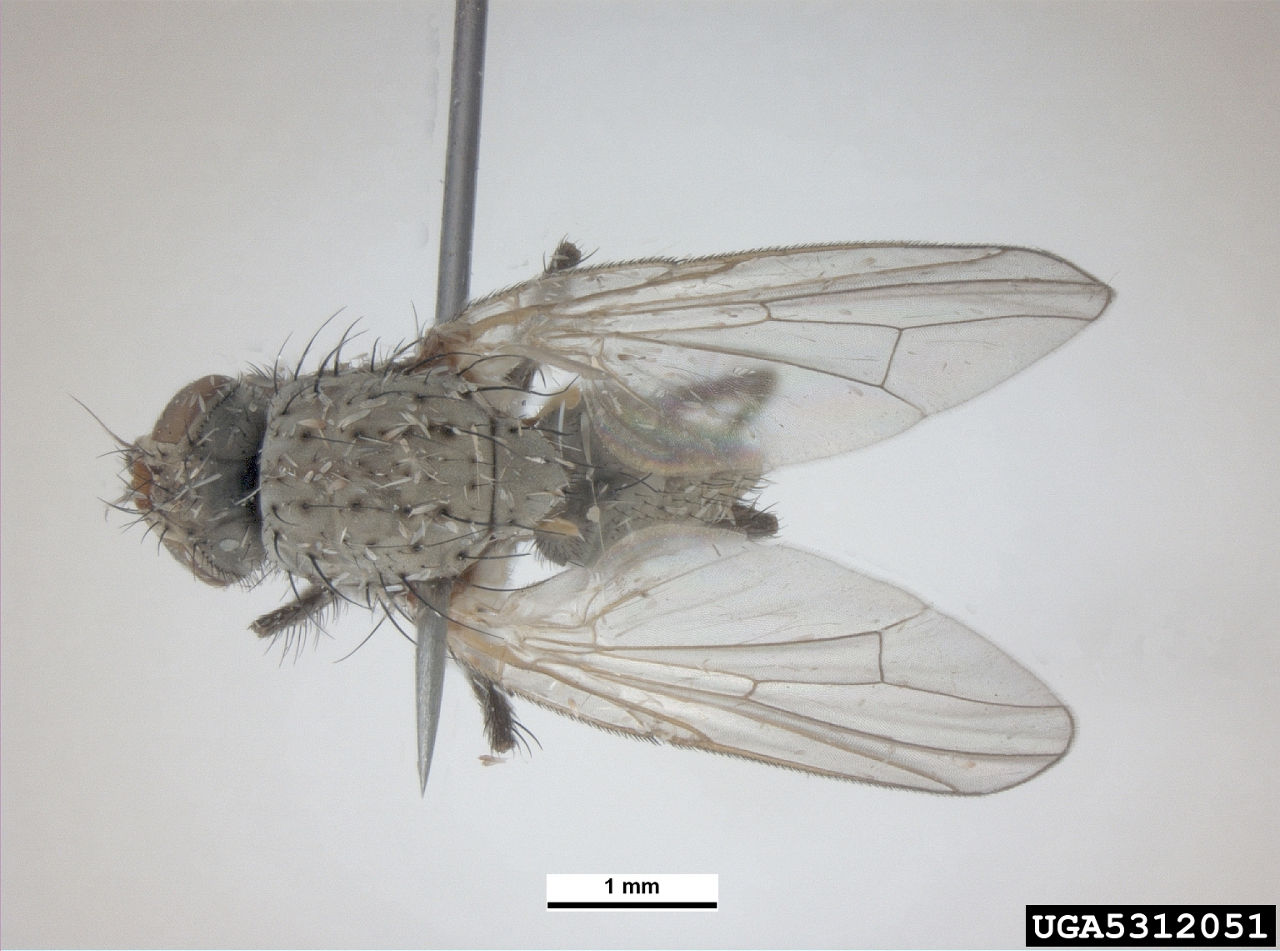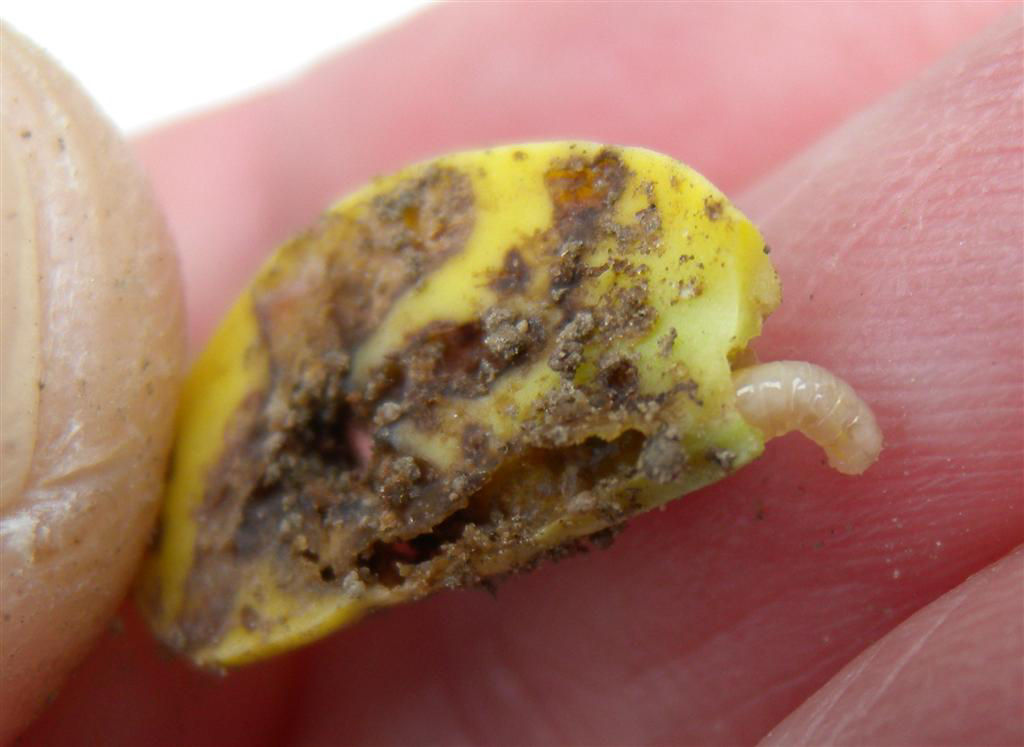Seed Corn Maggot Identification and Management
March 19, 2024
The seedcorn maggot, Delia platura, is a common pest that can affect corn and soybean fields during germination and emergence. The risks associated with larval feeding include a reduced stand which may result in the need to replant and potential yield loss.
Insect Identification
Seedcorn maggots have four distinct lifecycle stages: Egg, Larva, Pupa and Adult. Typically, the larva, pupa and adult phases are easiest for identification purposes.
Larva:
Seedcorn maggot larva are white, legless, 1/5 inch to 1/4 inch in length and tapered towards their head and found in the soil (Figure 1). They have hooked mouthparts that are black in color, which they utilize to feed on the portion of the seed that is soft.

Pupa:
Seedcorn maggot pupa are brown, similar in size to wheat seed, and found in the soil.
Adult:
Seedcorn maggot adult flies are typically brown to grey, have red eyes are up to 1/5 inch to 1/4 inch long, and are about half the size of normal house flies (Figure 2).1

Life Cycle
In the fall, female seedcorn maggot flies deposit their eggs in debris and around plant stems near the soil surface.2 The eggs hatch and the larvae develop into the overwintering pupae. In early springtime, the flies emerge from the soil around 360 GDU’s (GDU’s accumulated from January 1, with a base of 39°F). These adults lay their eggs, which then cycle into larvae (which cause the most damage to crops) to pupa (known as the “Fly-free”) period and back to adults. There are typically 3 to 4 generations/year depending on weather and location in the United States (Table 1).
Table 1. Seedcorn Maggot Life Cycle and Activity by Growing Degree Days***

Damage:
The main period of damage occurs to crops during the larval stage. The larvae feed on the seed, killing the germ, or feed on mesocotyls in corn and soybean hypocotyls or cotyledons that are trying to emerge from the ground (Figures 3 and 4). Typically, most of the damage happens in years when emergence is delayed by cool, wet periods. The feeding causes the seed to not germinate or if it does germinate, the seedlings are weakened and usually die. To find potential feeding, look for areas with poor stands and look for the maggots, pupae, and damaged seed or seedlings. The damage tends to be field-wide compared to patch situations like many other pests.1


Management
Fields that have been recently tilled (less than 2 to 3 weeks prior to planting) and were in sod, cover crops, or were recently manured are at the highest risk for egg laying. The adult flies are looking for decaying vegetation or high organic matter fields that have been recently tilled.
There are cultural and chemical controls that are available to manage seedcorn maggots.
Cultural Control
No-till fields are less attractive to adult females compared to freshly tilled ground. If tilling, waiting a minimum of two weeks before planting allows the seedcorn maggots to develop and move to another host.2 Another cultural management control is to plant fields during the “Fly-free” period of their life cycle, based on GDU’s starting from January 1st of that given year (Table 1). This should allow the seed to germinate and emerge, while limiting the feeding by the maggots.
Chemical Control
There are multiple chemical control options that should help eliminate high levels of feeding. Using insecticide treated seed (for example, Clothianidin 0.25 mg ai/kernel – 1.25 mg ai/kernel) or soil insecticides at planting (for example, Terbufos 5 to 6 oz/1000 feet of row) are options.3
Brook Mitchell
Channel Agronomist
Sources
1Dean, A, and Hodgson, E. Seedcorn maggot. Integrated Crop Management. Iowa State University Extension. https://crops.extension.iastate.edu/encyclopedia/seedcorn-maggot#:~:text=Seedcorn%20maggots%20overwinter%20in%20Iowa,days%20before%20emerging%20as%20adults.
2Schmidt, E., Regan, K., and Barbercheck, M. 2022.Seedcorn maggot as a pest of field corn. PennState Extension. https://extension.psu.edu/seedcorn-maggot-as-a-pest-of-field-corn#:~:text=Description%20and%20Life%20Cycle,a%20yellowish%20tinge%20in%20color.
3Kelly, H.M. and Brown, S. Below ground (soil) insect pests. The University of Tennessee Institute of Agriculture.https://guide.utcrops.com/corn/corn-insect-guide/below-ground-soil-insect-pests/.
Websites verified 1/10/2024. 1110_349351